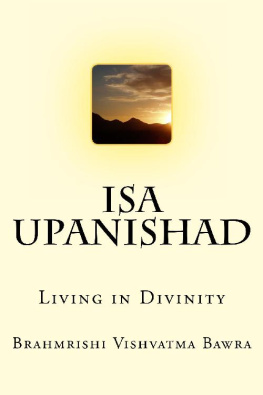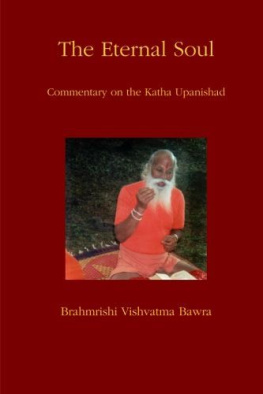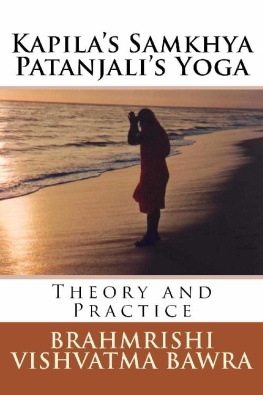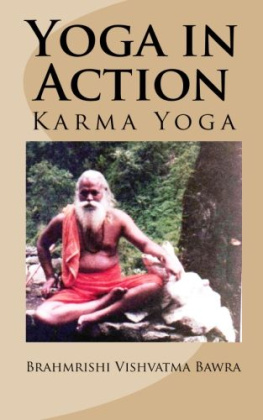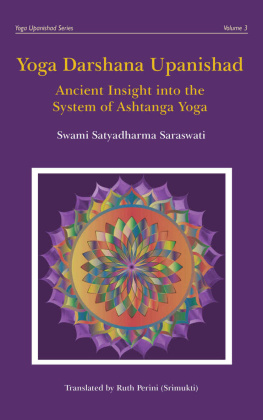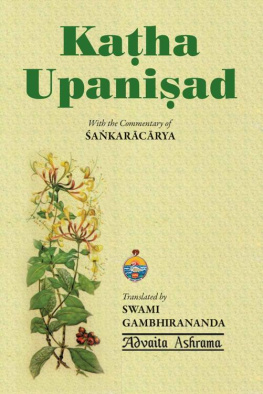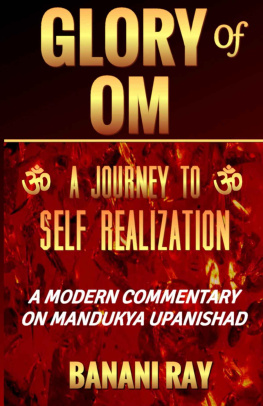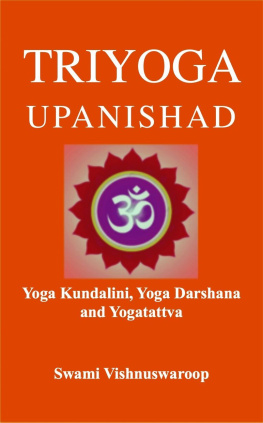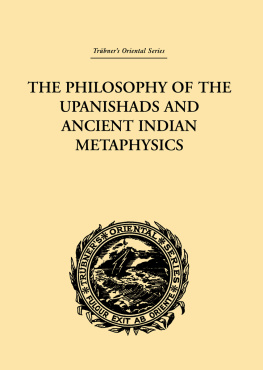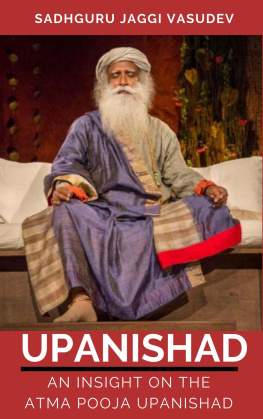Brahmrishi Vishvatma Bawra - Isa Upanishad
Here you can read online Brahmrishi Vishvatma Bawra - Isa Upanishad full text of the book (entire story) in english for free. Download pdf and epub, get meaning, cover and reviews about this ebook. year: 2012, publisher: Brahmrishi Yoga Publications, genre: Religion. Description of the work, (preface) as well as reviews are available. Best literature library LitArk.com created for fans of good reading and offers a wide selection of genres:
Romance novel
Science fiction
Adventure
Detective
Science
History
Home and family
Prose
Art
Politics
Computer
Non-fiction
Religion
Business
Children
Humor
Choose a favorite category and find really read worthwhile books. Enjoy immersion in the world of imagination, feel the emotions of the characters or learn something new for yourself, make an fascinating discovery.
- Book:Isa Upanishad
- Author:
- Publisher:Brahmrishi Yoga Publications
- Genre:
- Year:2012
- Rating:3 / 5
- Favourites:Add to favourites
- Your mark:
- 60
- 1
- 2
- 3
- 4
- 5
Isa Upanishad: summary, description and annotation
We offer to read an annotation, description, summary or preface (depends on what the author of the book "Isa Upanishad" wrote himself). If you haven't found the necessary information about the book — write in the comments, we will try to find it.
Brahmrishi Vishvatma Bawra: author's other books
Who wrote Isa Upanishad? Find out the surname, the name of the author of the book and a list of all author's works by series.
Isa Upanishad — read online for free the complete book (whole text) full work
Below is the text of the book, divided by pages. System saving the place of the last page read, allows you to conveniently read the book "Isa Upanishad" online for free, without having to search again every time where you left off. Put a bookmark, and you can go to the page where you finished reading at any time.
Font size:
Interval:
Bookmark:
a Upanishad
Living in Divinity
From Lectures of
Brahmrishi Vishvatma Bawra
Edited by
William F. Milcetich
Brahmrishi Yoga Publications
Publisher: Brahmrishi Yoga Publications
BrahmrishiYoga.org
Date: December .
Brahmrishi Yoga Publications
All rights reserved
No part of this book may be used or reproduced in any manner without written permission, except in the case of brief quotations embodied in critical articles and reviews.
Printed in United States of America
Library of Congress Control Number: 2012953124
ISBN: 978-1480197503
Acknowledgement
I am indebted to Swami Vishva Bharti and Shyam Sehgal. Swami Vishva Bharti transcribed the original Hindi lectures and researched the citations used during the lectures of Swami Bawra. This work was published in Hindi by Divine Radiance Publications as Brahma Vidya Vigyan . Shyam Sehgal translated the Hindi publication into English. The first seven mantras were published by Divine Radiance Publications as The Science of Absolute Knowledge . Sehgals English translation aided the creation of this commentary.
I am indebted to my wife, Margot Milcetich, for her encouragement and careful editing. Thank you to Keith Lazuka, Lisa Thiel and Julie Tamarkin for reading and suggesting clarifications.
In honor of Swami Bawras vision for education, all proceeds of this book will go to a free school he established in Jabalpur , India .
This book is inspired by a series of lectures on the a Upan i shad by Brahmr ishi Vishvatma Bawra given in Waterloo , Ontario , Canada in . The work is a presentation of the spiritual science of Brahma Vidy , knowledge of one Supreme Source of life, and incorporates Swami Bawras ideas on Vednta in accord with the Vaishhnava tra dition.
Brahmrishi Vishvatma Bawra was born in a small Indian village near Varanasi in 1934. As a child, h e shied away from school and had no formal education. At the age of eighteen, he was enlightened by the touch of a great yogi , Bhagvan Chandra Mauli, and remembered many previous lives spent with his guru. Under his gurus guidance, Swami Bawra left his family to study higher spiritual practices in Ayodhya at the principal center of the Vaishnava Order. By the grace of his master he received a distincti ve memory of scripture and philosophical treatises. He became a learned yogi of the Vaishnava Sanyasi Order.
Swami Bawras teachings emphasize the spiritual science of Brahma Vidy , knowledge of the source of life in Brahman . Brahma Vidy has two aspects, theory and practice. In the Upanishads and Bhagavad Gt , the theory is called Smkhya, and the practical aspect is called Yoga. On the basis of his own experiences, Swami Bawra taught a higher practice called Maha Yoga for realizing ultimate truth and fin ding freedom from suffering. His teachings are universal and accessible.
My wife Margot and I studied with Swami Bawra for twenty years. In 2005, Margot founded Brahmrishi Yoga Teacher Training based on Swami Bawras inspiration and guidance. In 2006, I retired from my professional career and began to compile and edit Swami Bawras lectures into books. Additionally, I teach meditation and philosophy for Brahmrishi Yoga.
To assist the English reader with the pronunciation of fr e quently used Sanskrit terms, letters have been added to the strict transliteration of Sa n skrit to English. For example, citta is written as chitta . T he long vowels of a, i, and u are indicated by the symbols, , , and and are held for a longer time. L ong is pronounced as in fathe r , long as in the double ee of week , and as in rude. And the sh sound is indicated by . Capitalization is always a deliberate choice as there is none in Sanskrit. In this text, Brahman , vara , God, and all terms related with the Supreme are capital ized. Traditionally, the pr o noun for formless Brahman is That , and with form it is He. Further explanation is within the text.
The word V e da means knowledge . T he Vedas are an ancient compilation of universal truth. The y are considered divine revelation, existing from time immemorial, and delivered by the Supreme Lord at the dawn of this manifestation. Infinite knowledge was not created, nor is knowledge a limited function or quality of the Supreme Self ; knowledge is eternal consciousness itself. Consciousness and knowledge are two names of one truth . Truth or knowledge is indivisible, infinite, and beyond the influence of time, space, and circumstances. It exists eternally in the form of cosmic sounds and vibrations and facilitates the evolution of living organisms toward achieving the highest perfection in life.
Knowledge is never stale; it remains fresh, useful, universal, and pe r ennial. At any time, knowledge can be known, understood, and applied. Therefore, Vedic wisdom is understood a s eternal, having the ever-present capacity to guide human intelligence in a direction that befits the righteous needs of its own era. The ete r nal truth of the V e das is called san tana , ever-fresh. San tana has been referred to as ancient, but the Atharva Veda defines san tana as ever-new and beginningless. Therefore, the study and practice of this well-spring of knowledge and consciousness has been known as San tana Dharma : the righteous path of eternal truth .
The Vedas are a collection of Sanskrit poet ry, ritual treatises, dialogues and philosophical discourses composed over a period of many centuries by seers , rishis . They are considered revealed because they were heard by seers in meditative states and thus are called ruti , that which is heard. This distinguishes them from other religious texts, which are called smrti or that which is remembered. T he Vedas ha ve four divisions: Rig , Sma , Yajur , and Atharva . Rig is related with the knowledge of divine power and its agencies; it discusses the cause, qua lities and forms of divinity. Sma explains devotion and how to approach divinity through sound and prayer. Yajur is the teaching of action: how to put knowledge and love into practice. The last Veda, Atharva , is the teaching of union with S upreme Brahman .
Each Veda is compiled into two sections: S a mhit and Br hmana . San tana Dharma considers Samhit to be a revelation of s u preme knowledge, while Br hmana is commentary on the Samhit by self-realized seers. The Br hm a na section is further divided into two comme n taries: Br hmana and ranyaka . Br hmana provides instructions about the use of Vedic mantras in ritual, and the methods of sacrificial ceremony. ranyaka is an exposition for study, analysis, and reflection upon Vedic mantras . In other words, the met hod of applying Vedic mantras in religious ceremonies is the subject of Br hmana , and the understanding of the spir i tual principles underlying the use of mantra is the subject of ranyaka .
Vedic literature concludes with the teaching of the Upanishads. Th e Upanishads are the gist of the knowledge contained in the Samhit , Br hmana , and ra n yaka . They are the realizations and enunciation of supreme truth by great seers. The Upan i shads have been called the mysterious or secret teaching s of the Vedas . T he y pr ovide the crucial knowledge of how to find and live near the Supreme Self . The questions that arise as one seeks to realize the S upreme C ause and find liberation from suffering are addressed .
The Upanishads are the principal support for the tradition of San tana Dharma , the perennial search for truth that is independent of religion . In the early Vedic period, rituals had a great importance because heaven was believed to be the aim of life. Sacrificial rites were performed to attain both worldly and heavenly affluence and pleasure. But i n the Upanishadic tradition, rituals have no place in the pursuit of the truth of San tana Dharma . The purpose of divine knowledge is to guide us toward a direct, personal experience of immortality, which liberate s us from suff ering . T he Upanishads recommend meditation, direct experience that refines the intellect and leads to truth.
Font size:
Interval:
Bookmark:
Similar books «Isa Upanishad»
Look at similar books to Isa Upanishad. We have selected literature similar in name and meaning in the hope of providing readers with more options to find new, interesting, not yet read works.
Discussion, reviews of the book Isa Upanishad and just readers' own opinions. Leave your comments, write what you think about the work, its meaning or the main characters. Specify what exactly you liked and what you didn't like, and why you think so.

